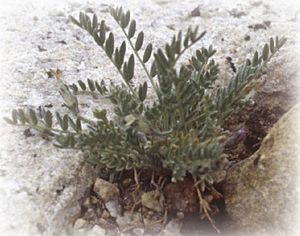Leadville milkvetch facts for kids
Quick facts for kids Leadville milkvetch |
|
|---|---|
 |
|
| Conservation status | |
| Scientific classification |
Astragalus molybdenus, also called the Leadville milkvetch or molybdenum milkvetch, is a type of flowering plant. It belongs to the legume family, which includes peas and beans. This plant is special because it grows naturally only in Colorado, United States. Sometimes, scientists include similar plants from Wyoming and Montana with it.
Why is it Called That?
This plant has an interesting name story! It was first found near Leadville, Colorado. Because it looks a bit grayish, it was first named Astragalus plumbeus. But there was already another plant in Asia with that exact name. So, scientists had to change it.
The new name, A. molybdenus, comes from the metal Molybdenum. Molybdenum is also grayish. It is mined a lot near Leadville, where this plant was first found.
What it Looks Like
This plant is a small, long-lasting herb. It grows from a main root called a taproot. It also has underground stems that branch out. These underground stems can sprout new plants. So, what looks like two separate plants might actually be one big plant connected underground!
The plant's leaves and stems are covered in tiny hairs. This makes the plant look silvery or ash-colored. Its leaves are made up of many smaller parts, sometimes up to 25 tiny leaflets. These leaflets can even be folded.
The flowers of the Leadville milkvetch are usually purple. They can also be pinkish-purple or white with purple stripes. These pretty flowers bloom from late June to early August. After the flowers, the plant grows a fruit. This fruit is a legume pod, like a small pea pod. It is about one centimeter long and holds the plant's seeds inside.
Where it Grows
The Leadville milkvetch loves to grow high up in the mountains. It lives in the alpine tundra of the Rocky Mountains. This is a very cold and windy place. Sometimes, it can also be found in slightly lower areas called subalpine zones.
Most of these plants grow at very high elevations. They are found between 3,600 and 4,000 meters (about 11,800 to 13,100 feet) above sea level. It prefers to grow on rocky, chalky soils, like broken limestone. It can even grow on loose, rocky slopes called scree. Its branching underground parts help it stay stable in these loose rocks.
This plant can grow in areas with few other plants or in places with lots of vegetation. It can also grow in both dry and moist spots. You might often find it in places where snow stays on the ground for most of the year. Other plants that often grow near it include Claytonia megarhiza, Kobresia species, Oxyria digyna, and Silene acaulis.
What Threatens This Plant?
The Leadville milkvetch faces a few challenges. Some of these include mining activities in the area. Outdoor fun like hiking and using off-road vehicles can also disturb its habitat. Lastly, changes in the world's weather patterns, known as global climate change, could also affect where and how well it grows.


